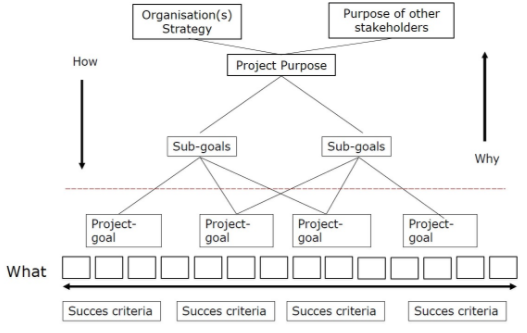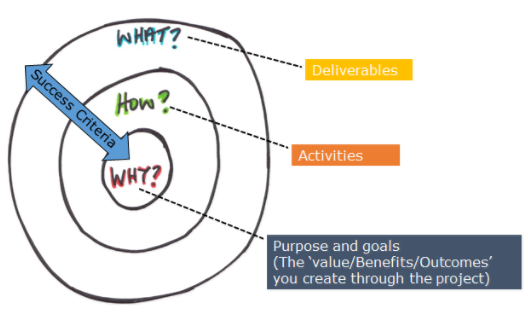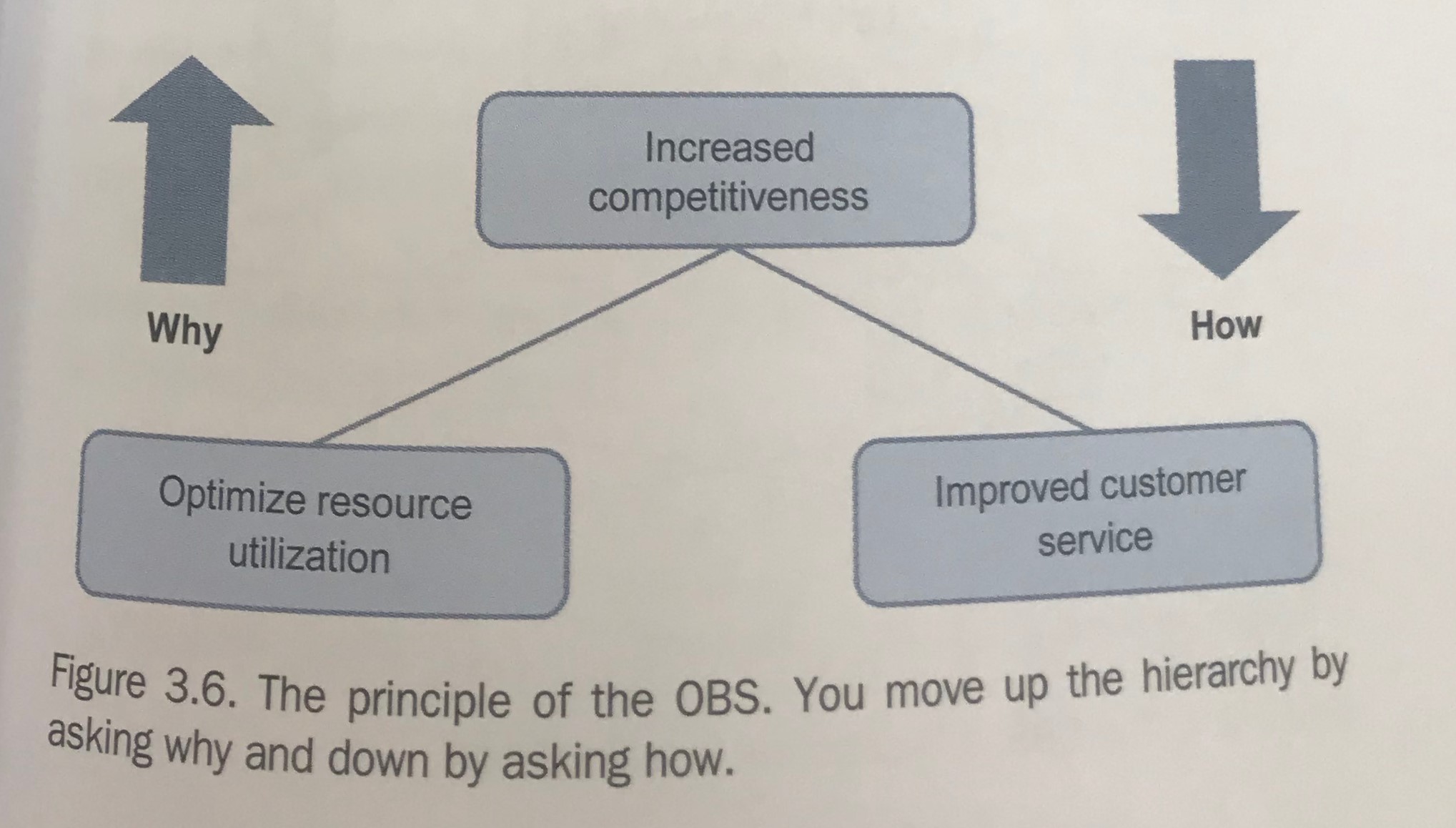Goal hierarchy or Goal Breakdown Structure
Contents |
Abstract
Purpose is the reason why a project exists. However, the purpose of a project, program or portfolio (PPP) needs to be crystallised in to a desirable strategy to generate the intended benefits. The goal hierarchy or goal breakdown structure helps to transform and break down a PPP's purpose into more manageable goals, sub-goals, and deliverables, while maintaining a clear connection to the PPP's main purpose. The aspect of creating a clear goal hierarchy is applicable and is important in projects, programs and portfolios. The PMI standard for program management describes the process of creating a goal hierarchy as “goal setting” by “To facilitate alignment and goal setting, the organization’s strategic plan is further delineated as a set of goals and objectives that may have measurable elements such as products, deliverables, benefits, cost, and timing, among others. The goal of linking the program to the organization’s strategic plan is to plan and manage a program that will help the organization achieve its strategic goals and objectives and to balance its use of resources while maximizing value.” [1] . This statement both displays a method of crystallising the main goal in to a structure of more concrete lower level sub goals of products, benefits, deliverables and so forth. The statement also exemplifies that the intended benefits of using a clear goal hierarchy is to help an organisation achieve its goals while maximizing the value.
This article will provide an overview of the topic of creating a goal hierarchy with the use of the management method, goal breakdown structure (GBS). The article will provide a brief overview of the literature and areas where a goal hierarchy can be applied and what benefits it is intended to generate. The article will also provide examples of how to create a desirable goal hierarchy using the GBS method. This article will mainly exemplify GBS applied in project management, but it should be noted that the methodology is equally applicable in program and portfolio management as well.
Introduction
The term “goal hierarchy”, “goal setting” or “goal breakdown structure” is mentioned in literature of all sorts. Some literature refers to the terminology as a method for creating personal success, A. Duckworth argues that one major component for one person’s success is their ability to have “passion and perseverance for long time goals” . S. Sieneke argues in his book “Start with why” that the same is true for big businesses. He uses the tech company Apple as an example of how a clear goal strategy internally at Apple help them to become the market giants they are today. Apples clear communication of, not only WHAT and HOW they produce their products and services, but also WHY they do it, made Apple the supreme competitor on the market. A clear and solid goal setting technique should help project, program or portfolio managers to construct a goal hierarchy which can align and optimise decision making in the organization, as well as help to communicate the all so important WHY to the customers, as S.Sieneke argues. The term "goal breakdown structure" was first mentioned in the publication” Setting Goals and Expectations” where the authors abbreviates the term as GBS [S.Bender et al] . GBS is often presented as an alternative method to Work breakdown structure (WBS). WBS structures an organisations strategy to achieve the PPP’s main purpose after tasks to be completed, GBS structures an organisation after goals or objectives to be achieved. Both the WBS and GBS are heirecal three structures, where the top level in the hierarchy consists of the projects overall and main purpose. A.Berniz in his article “The goal break down structure”, argues that the main difference (and implied benefits) of a GBS compared to standard milestones strategy of a project, is that all the achieved goals is valued delivered to the business, regardless if the project is terminated prematurely .
How to create a goal heirarchy by using GBS
During program definition, the program manager collaborates with key sponsors and stakeholders to develop the program’s business case. This business case is developed to assess the program’s investment against the intended benefits.
Purpose (why)
Give overall meaning to the project and why it is interesting. It projects the goal of what the project should complete. Identification of the purpose starts by finding the answer the question why.
Deliverables (how and what)
Deliverables or product goals is the final delivery at the project termination. The deliverables describe how the purpose is reached while the project ends. It is the final product emerging from the project. This stage in the hierarchy is the more detailed stage than the purpose.
Success factors
Describes the effect from the deliverables completed in the project. Here is how asked again for instance how can the purpose be measured? Success factors are often defined as the second form in the project initiation phase but during project completion they are measured at the completely end of the project. The idea is to create a hierarchy as displayed in the figure below.
Similar to the argument put forward by Simon Sinek in the so called Golden Circle (see TED talk- add the link to it), we start with why (the purpose), and then move into to define exactly how we will do it (the different tasks) and what (the specific deliverables we need to create).
By creating a relationship between why (purpose, goals and sub-goals), how (activities) and what (deliveries) and success criteria (how to measure whether the goals have been achieved), we provide a clear purpose for all activities being undertaken by the project, which helps increase motivation and engagement with project.
Application
The goal setting is often the very first process initiated after the decision to carry out the particular project, however, depending on the project type some parts of the goal setting will be moved to next stages. As mentioned earlier the goal or purpose makes the desirable picture of the future. According to the book Power of Projects real leadership and management can first be initiated when the goal is defined. To utilize a goal in management the forms purpose, deliverables and success factors are created. By those means the goal can be specific and hence the project will be a project and not just a group of people. The goal hierarchy helps the project team matching expectations, negotiating contracts, engagement of team, coordinating activities, to learn and gain experience. Defining the goal is applicable and important in every project but can differ depending on the project type. The goal hierarchy is also a tool to confine a project – specifically when more projects are started with similar visions. The goal hierarchy and the why, how and what is essential for a project’s further course and measuring of the deliverables at project termination.
Limitations
There is a certain risk that some team members can’t identify themselves with the purpose and they can probably feel overlooked while the deliverables are defined. Leading to less work spirit and team building. As well is there a risk that deliverables and success factors are diffuse and that the correlation between resources and what the team has to deliver isn’t sufficient. It is therefore central to spend time on goal setting and the different forms in the hierarchy. Avoiding being thorough in this part will lead to unsatisfied project members and thus ineffective and counterproductive work causing time and financial waste. Because knowledge is limited in the imitation phase of the project the team doesn’t always know when they have identified best deliverables and best success factors to measure purpose. A too fast forward going approach won’t necessary uncover best deliverables but time and costs will probably already push the team at this stage of the project.
Annotated Bibliography
Attrup, M. L. and Olsson, J.R., 2013
Their book provides back ground knowledge of goal setting in projects as well as providing tools and case examples giving a better understanding of how to deal with goal setting. A goal set the overall direction but they come up with the remaining important features goal setting does for a project. It will be interesting to further read and use on own projects due to the case stories and descriptions of how to use the goal hierarchy appropriately on different sorts of projects.
References
- ↑ The Standard for Program Management — Fourth Edition, Project Management Institute, 2017. ProQuest Ebook Central, http://ebookcentral.proquest.com/lib/dtudk/detail.action?docID=5180851.


